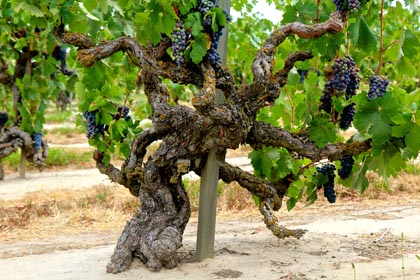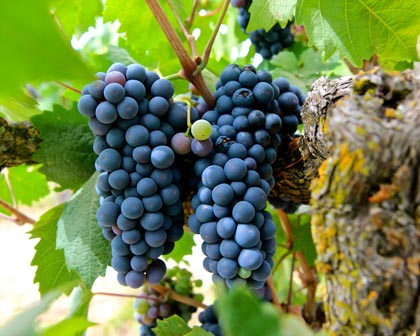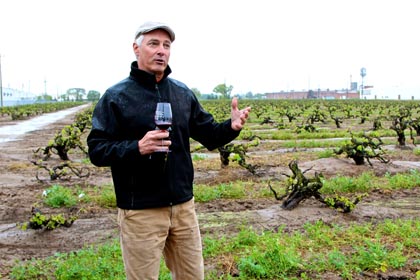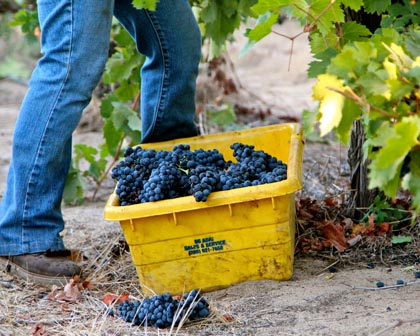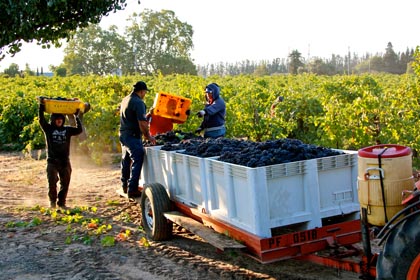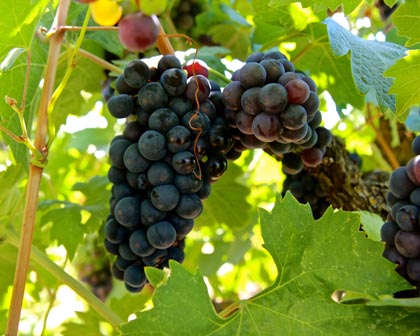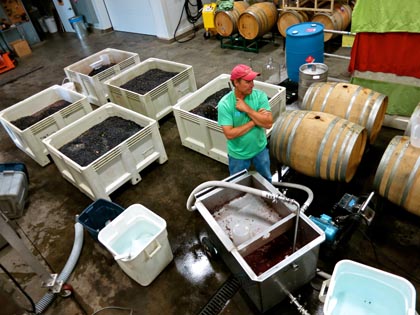Letters from Lodi
An insightful and objective look at viticulture and winemaking from the Lodi
Appellation and the growers and vintners behind these crafts. Told from the
perspective of multi-award winning wine journalist, Randy Caparoso.
Appreciating Zinfandels (especially from Lodi) like a sommelier
Majestic, own rooted “old man” Lodi Zinfandel (planted in 1901) in Mohr-Fry Ranches’ Marian’s Vineyard
In seminars at the 2014 Zinfandel Advocates & Producers Experience (i.e. ZAP) in San Francisco this past January, some of California's top sommeliers presented Zinfandels from their perspective: in terms of terroir, or "sense of place."
Why terroir; and not, say, varietal character? The Zinfandel grape produces red wines that, more than others, are usually appreciated or evaluated in terms of their fruit profile – a rich, full, often jammy berryishness – rather than sensations reflecting geographic origins.
Zinfandel in Marian’s Vineyard
But for many wine lovers, Zinfandel can be just as noble a varietal as, say, Cabernet Sauvignon, Pinot Noir, or any other black skinned variation of Vitis vinifera. When you appreciate Zinfandel like this, you appreciate it for its place of origin — even more than how much it tastes of the grape. Intensity is no longer the prevalent factor when judging Zinfandels in this fashion; even more important are the complexities and subtleties derived from vineyard or regional distinctions.
Case in point: Ridge Vineyards, one of the pioneers of modern day California Zinfandel, and still one of the most prestigious. Some time ago Ridge stopped putting “Zinfandel” on their labels. What you see instead are place names, such as Benito Dusi Vineyard in Paso Robles, and Lytton Springs, Pagani or Geyserville in Sonoma County. This is partly because Ridge’s bottlings are often (not always) field blends, in which Zinfandel is the chief component. But mostly it is because they are saying they no longer produce wines that are supposed to taste like Zinfandel; but rather, wines that taste like Benito Dusi, Lytton Springs, Pagani or Geyserville.
At the regional seminars presented by sommeliers at last January's ZAP, there were two different bottlings by Ridge presented by two different speakers. One of them was the latest Benito Dusi from Paso Robles – a region that is becoming increasingly better known for Zinfandels with soaring fruit anchored by unusually high, edgy acidity derived primarily from the presence of alkaline (pH as high as 8.0), calcareous soils. Zinfandels produced by wineries such as Turley Wine Cellars and DAOU Vineyards typify this highly perfumed, high-acid style.
Ridge's Benito Dusi, however, is not grown in typically rocky, calcareous Paso Robles soils; but rather, on a flatter, lower pH section of the region, consisting of alluvial gravelly loam. The result is a lusher, looser, rounder style of Paso Robles Zinfandel than Turley's or DAOU's: different – neither lesser nor "better," but certainly just as good and interesting.
Macchia winemaker/owner Tim Holdener among tiny +100-year old Noma Ranch vines on Lodi’s east side
In his talk on Dry Creek Valley Zinfandels, Bob Bath – a Master Sommelier and instructor at C.I.A. Greystone – presented another Zinfandel by Ridge: the 2012 Lytton Springs from Sonoma County, which came across as almost a caricature of the varietal character many wine lovers associate with Zinfandel – big and steel girded/tannin structured, while briary, brambly, jam packed in both red and black berryish fruit. According to Bath, "Consistency of varietal character is what Dry Creek Valley terroir is all about… it is to Zinfandel what the Napa Valley is to Cabernet Sauvignon."
Christopher Sawyer – at the time, the wine director at Sonoma's Carneros Bistro – also presented typical Sonoma style Zinfandels; describing Carol Shelton's Karma bottling as "rich, plush, quintessential," and St. Francis's Serres Ranch Zinfandel as "ripe, robust, opulent."
Zinfandel harvest in Lodi’s Lizzy James Vineyard
This is all fine and dandy, but what if you don't like red wines that are "big," "ripe," "opulent," tannin girded or high in alcohol? This doesn't mean you can't appreciate Zinfandel, because not all of them are like that. In fact, almost the opposite of the aggressive Sonoma styles are the Zinfandels grown in the Lodi AVA, which were shown by planetgrape.com's Catherine Fallis MS at the last ZAP.
Commented Fallis, on classic Lodi Zinfandels such as Harney Lane's Lizzy James, St. Amant's Marian's Vineyard, and McCay's Trulux: "These Zinfandel styles are not punchy or oversized… they rely on more of a subtle, balanced, grounded intensity, very much a reflection of Lodi's steady, dependable Mediterranean climate – complex and characterful in their own way."
Which is not to say that all Lodi Zinfandels are exactly like this. For instance, there are certain recognized branded styles of Lodi Zinfandel – such as Klinker Brick, or Michael David Winery's Earthquake – that are fashioned more in the aggressive, lavishly fruited style somewhat like Sonoma's; garnering more than their shares of awards for this, too.
Vice-versa, there are first class Sonoma Zinfandels – such as those of VML, Nalle, and Quivira – that go for more restraint and subtlety; perhaps not quite as gently or curvaceously as the more feminine styles of Lodi, but enough to demonstrate that the hands of growers and winemakers can have as much of an impact as terroir.
Yet in some parts of California, terroir is the dominant factor no matter what a grower or winemaker wants to do. In dramatic contrast to both Sonoma and Lodi are the high-elevation Zinfandels of Mendocino Ridge; presented at ZAP by Ellen Landis CS, CSW, the owner/sommelier of Landis Shores Oceanfront Inn in Half Moon Bay.
Commenting on Mendocino Zinfandels such as Steele's DuPratt and Witching Stick's Fashauer Zinfandels, Landis said: "You get a strong thread of minerality, much sharper acidity as well as lower alcohol in Mendocino Ridge than anywhere else. Although alcohols in Zinfandels from the lower parts of Mendocino can get up to 16%, you generally find more restrained alcohol, and a lovely sense of elegance, in wines from the higher elevation vineyards."
2013 Zinfandel harvest at Lizzy James Vineyard on Lodi’s east side
Tracey Berkner, the owner/sommelier of Plymouth's Restaurant Taste, drew attention to the mountain grown Zinfandels of Sierra Foothills. Citing wines like Cedarvillle and Lava Cap's Reserve – both grown in El Dorado's granitic slopes, in vineyards located more than 2,500-ft. high – Berkner talked about "distinguishing nuances of pepper, herbal and earthy notes… especially minerally and woodsy qualities going beyond the usual Zinfandel fruitiness."
Lizzy James Vineyard Zinfandel (planted 1904)
Rob Renteria, the sommelier at San Francisco's La Folie, commented, "There are a lot of different Zinfandels appealing to a lot of different tastes." Renteria invited Bill Easton, the owner/winemaker of Terre Rouge and Easton, to help draw a picture of Amador County; a hillside region marked by "elevations from 500 to 2,300-ft., and 30° to 35° temperature swings that allow for good acidity."
Typifying the extremes found in Amador County, the Easton Rinaldi Zinfandel, produced from 100 to 120-year old vines, came across as lean and sinewy compared to the lush styles of Sonoma County and the gentle styles of Lodi; with a unique touch of rusticity, and more restrained varietal berryishness.
Different strokes, in other words, for different wine regions.
Sommeliers may have a geekier approach to wine than the average wine lover; but their tastes are not much different than any old-time wine lover who grew up with a taste for European style wines, and all the variations of classic European vineyards and wine regions.
Your average professional sommelier – one who actually labors in a restaurant, or works as a wine educator – cannot help but look at wines as something more than the sum of grapes or varietal assumptions. For that reason, sommeliers tend to adore terroir driven diversity, and are somewhat put off by numerical scores that pigeonhole varietal standards (this is the reason you don't find 100-point "scores" on restaurant wine lists) — as if all Zinfandels must taste alike, no matter where they are grown.
If you prefer a Zinfandel that goes beyond the usual expectation of big alcohol and ultra-ripe fruitiness, you'll find plenty of examples to suit your tastes. If you like your Zinfandel lean, sharp or sinewy, the Sierra Foothills or Mendocino Ridge may be the regions for you. If you lean towards a softer, more delicate, gentle, floral style, Lodi Zinfandels may be as good as it. You may even find yourself circling back and appreciating the big, ripe, jammy, yet firmly structured styles of Sonoma County all the more.
The important thing is to appreciate Zinfandels for what they really are rather than what you are told they are supposed to be. Free your mind, and you'll only increase your appreciation of Zinfandel like any of the other great red wines of the world: wines that taste as much of the place as the grape.
Harney Lane owner/grower Kyle Lerner among fermenting macro-bins of Lodi Zinfandel
